Millions of years ago, the plains of North America, Asia, and Europe were roamed by a peculiar group of carnivorous mammals known as the ‘bear dogs’. These animals came in all sorts of shapes and sizes, and resembled both bears and dogs in some features, hence the name. While some species could grow as big as a lion or bear, some forty million years ago in what’s now Texas at least two species of bear dogs were far less impressive in stature. One is the size of a chihuahua while the other is no bigger than a housecat.
The two specimens were discovered three decades ago in rather poor conditions — mostly fossil fragments. Since then, the fossils had been gathering dust at the Field Museum of Natural History in Chicago, Illinois, until one day Susumu Tomiya, who is a vertebrate paleontologist working for the museum, studied them with a fresh eye.
“I had just started at the Field, and I was getting the lay of the land, exploring our collections. In one room of type specimens, the fossils used as a standard to describe their species, I stumbled across something that looked unusual,” he says. “There were beautiful jaws of a small carnivore, but the genus the specimen had been assigned to didn’t seem to fit some of the features on the teeth. It made me suspect that it belonged to a very different group of carnivores.”
Due to their poor condition, the two species had been previously misclassified being grouped in wrong genus and family. Tomiya noticed however that one of the specimens had upper teeth whose surfaces looked like they were meant for crushing. This suggests that the animals not only ate meat, as the previous classification suggested, but also berries or insects, much like a fox diet today. This hint spurred him to investigate further. He later noticed that another fossil carnivore from the same rock formation in Texas also had similar features.
Eventually, Tomiya enlisted the help of Jack Tseng of the University at Buffalo and together made a 3D reconstruction of one of the skulls which was still relatively intact. Using high-resolution X-ray CT scans, the team could see internal skull features otherwise invisible. These scans showed that the two species are actually ‘bear dogs’ or amphicyonid.
As such, the species had to be re-classified. The chihuahua-sized Miacis cognitus is now renamed Gustafsonia cognita (in honor of Eric Gustafson, who first described them), and Miacis australis is now known as Angelacrtocyon australis, meaning “messenger bear dog.”
Both lived 36 to 37 million years ago and although earlier fossils were found in Europe, the new fossils suggest that southern North America was an evolutionary hot spot for the bear dogs. Their lineage eventually went extinct several million years ago. It’s not clear why, but around the time bear dogs collapsed the climate became cooler and drier. Meanwhile, actual bears and canines appeared who may have been more adapted and eventually took their place in the ecological niche.
“Studying how the diversity of beardogs waxed and waned over time could tell us about larger patterns in carnivore evolution,” Tomiya added.
Findings appeared in Royal Society Open Science.










